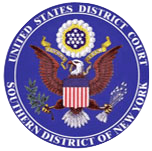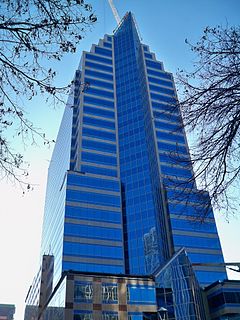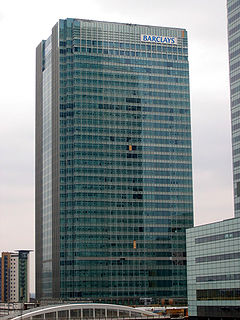
The Federal Reserve System is the central banking system of the United States of America. It was created on December 23, 1913, with the enactment of the Federal Reserve Act, after a series of financial panics led to the desire for central control of the monetary system in order to alleviate financial crises. Over the years, events such as the Great Depression in the 1930s and the Great Recession during the 2000s have led to the expansion of the roles and responsibilities of the Federal Reserve System.

The Aldrich–Vreeland Act was passed in response to the Panic of 1907 and established the National Monetary Commission, which recommended the Federal Reserve Act of 1913.

The Federal Reserve Act is an Act of Congress that created the Federal Reserve System, and which created the authority to issue Federal Reserve Notes as legal tender. The Act was signed into law by President Woodrow Wilson.

Banking in the United States began in the late 1790s along with the country's founding and has developed into highly influential and complex system of banking and financial services. Anchored by New York City and Wall Street, it is centered on various financial services namely private banking, asset management, and deposit security.
The Panic of 1819 was the first major peacetime financial crisis in the United States. It was followed by a general collapse of the American economy that persisted through 1821. The Panic announced the transition of the nation from its colonial commercial status with Europe toward an independent economy, increasingly characterized by the financial and industrial imperatives of central bank monetary policy, which made it susceptible to boom and bust cycles.

Fractional-reserve banking is the common practice by commercial banks of accepting deposits, and making loans or investments, while holding reserves at least equal to a fraction of the bank's deposit liabilities. Reserves are held as currency in the bank, or as balances in the bank's accounts at the central bank. Fractional-reserve banking is the current form of banking practiced in most countries worldwide.

This history of central banking in the United States encompasses various bank regulations, from early "wildcat" practices through the present Federal Reserve System.

In banking and finance, clearing denotes all activities from the time a commitment is made for a transaction until it is settled. This process turns the promise of payment into the actual movement of money from one account to another. Clearing houses were formed to facilitate such transactions among banks.
The Independent Treasury was the system for managing the money supply of the United States federal government through the U.S. Treasury and its sub-treasuries, independently of the national banking and financial systems. It was created on August 6, 1846 by the 29th Congress, with the enactment of the Independent Treasury Act of 1846, and it functioned until the early 20th century, when the Federal Reserve System replaced it. During this time, the Treasury took over an ever-larger number of functions of a central bank and the Treasury Department came to be the major force in the U.S. money market.

This article is about the history of the United States Federal Reserve System from its creation to the present.
A stress test, in financial terminology, is an analysis or simulation designed to determine the ability of a given financial instrument or financial institution to deal with an economic crisis. Instead of doing financial projection on a "best estimate" basis, a company or its regulators may do stress testing where they look at how robust a financial instrument is in certain crashes, a form of scenario analysis. They may test the instrument under, for example, the following stresses:
James Mark Pittman was a financial journalist covering corporate finance and derivative markets. He was awarded several prestigious journalism awards, the Gerald Loeb Award, the George Polk Award, a New York Press Club award, the Hillman Prize and several New York Associated Press awards.
This article details the history of banking in the United States. Banking in the United States is regulated by both the federal and state governments.

Bloomberg L.P. v. Board of Governors of the Federal Reserve System, 1:08-cv-09595, was a lawsuit by Bloomberg L.P. against the Board of Governors of the Federal Reserve System for disclosure of information about banks and other financial institutions that had borrowed from the Federal Reserve discount window during the United States housing bubble and ensuing financial crisis.
ICE Clear Credit LLC, a Delaware limited liability company, is a Derivatives Clearing Organisation (DCO) previously known as ICE Trust US LLC which was launched in March 2009. ICE offers trade execution and processing for the credit derivatives markets through Creditex and clearing through ICE Trust™. ICE Clear Credit LLC operates as a central counterparty (CCP) and clearinghouse for credit default swap (CDS) transactions conducted by its participants. ICE Clear Credit LLC is a subsidiary of IntercontinentalExchange (ICE). ICE Clear Credit LLC is a wholly owned subsidiary of ICE US Holding Company LP which is "organized under the law of the Cayman Islands but has consented to the jurisdiction of United States courts and government agencies with respect to matters arising out of federal banking laws."

The Suffolk System was the first regulatory banking system arrangement of remote banks created in the United States. Starting in 1824, the Suffolk Bank of Boston, Massachusetts, along with six other banks, created a system that required country (non-federal) banks to deposit reserve balances in one or more of the participating banks, which guaranteed that each country bank could redeem their banknotes in specie. The Suffolk Bank became one of the most profitable in the country and continued to operate under the Suffolk System until 1858, when rival institutions complained of dictatorial practices and eventually national legislation banned state banknotes. The Suffolk System was the predecessor to modern banking practices and led to the creation of the Federal Reserve that still operates today.

Joseph M. Otting is an American businessman and government official. He was sworn in as the 31st Comptroller of the Currency on November 27, 2017.
















